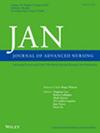经导管主动脉瓣植入术患者和护理人员可接受性的描述性定性研究
IF 3.4
3区 医学
Q1 NURSING
引用次数: 0
摘要
目的对经导管主动脉瓣植入术的可接受性进行结构化分析,以支持老年主动脉瓣狭窄患者及其护理人员的临床对话、决策和康复。虽然经导管主动脉瓣植入术是治疗心脏瓣膜疾病的有效方法,但其对患者和护理人员的可接受性尚不清楚。了解临床程序的可接受性是影响患者参与自我保健和指导患者和护理人员所需的信息和支持的关键。在Sekhon可接受性理论框架的指导下,采用演绎内容分析进行描述性定性研究。方法纳入2018-2020年澳大利亚三家大城市医院18例主动脉瓣狭窄患者(平均年龄84.2±4.1岁)和8名护理人员。半结构化访谈在tavi后4-6个月进行,并逐字记录。分析采用Sekhon的三个时间区可接受性理论框架,通过演绎编码检查情感态度、负担、伦理、干预一致性、机会成本、感知有效性和自我效能。结果经导管主动脉瓣置入术具有较高的前瞻性、并发性和回顾性可接受性。可感知的预期可接受性将该程序框定为挽救生命。围手术期,参与者发现手术过程简单,风险低,破坏性最小,确保了高并发可接受性。手术后,患者参与者描述了缓慢但逐渐恢复正常,信心增强,并重新参与了他们珍视的娱乐活动。缺乏结构化的康复建议导致自我设计的康复和不确定的安全限度。结论经导管主动脉瓣植入术被认为是一种高度可接受的干预措施,可以帮助这组主要是老年人实现他们的个人目标。尽管经导管主动脉瓣置换术具有微创性,但优化恢复和康复需要综合考虑临床需求和患者目标的方法。患者和公众贡献:概念化或设计中无。本文章由计算机程序翻译,如有差异,请以英文原文为准。
A Descriptive Qualitative Study of Patient and Carer Perspectives on the Acceptability of Transcatheter Aortic Valve Implantation
AimTo provide a structured analysis of the acceptability of transcatheter aortic valve implantation to support clinical conversations, decision making and recovery for older adults with aortic stenosis and their carers.BackgroundWhile transcatheter aortic valve implantation is an effective treatment for heart valve disease, its acceptability to patients and caregivers remains unclear. Understanding the acceptability of clinical procedures is key for influencing patient engagement in self‐care and guiding the information and support patients and carers need.DesignA descriptive, qualitative study used deductive content analysis, guided by Sekhon's Theoretical Framework of Acceptability.MethodsParticipants included 18 aortic stenosis patients (mean age 84.2 ± 4.1 years) and 8 carers from three Australian metropolitan hospitals (2018–2020). Semi‐structured interviews were conducted 4–6 months post–TAVI and transcribed verbatim. Analysis used Sekhon's Theoretical Framework of Acceptability across three temporal zones, with deductive coding examining affective attitude, burden, ethicality, intervention coherence, opportunity costs, perceived effectiveness and self‐efficacy.ResultsParticipants described high prospective, concurrent and retrospective acceptability of transcatheter aortic valve implantation. Perceived prospective acceptability framed the procedure as lifesaving. Peri‐operatively, participants found the procedure simple, low‐risk and minimally disruptive, ensuring high concurrent acceptability. Post‐procedure, patient participants described a slow but gradual return to normal, growing confidence and a reengagement with their valued pastimes. The absence of structured rehabilitation advice led to self‐designed recoveries and uncertainty about safe limits.ConclusionTranscatheter aortic valve implantation was perceived as a highly acceptable intervention that helped this group of mostly older adults achieve their personal goals.Relevance to Clinical PracticeDespite the minimally invasive nature of transcatheter aortic valve replacement, optimising recovery and rehabilitation requires a holistic approach that addresses both clinical needs and patient goals.Patient and Public ContributionNone in the conceptualisation or design.
求助全文
通过发布文献求助,成功后即可免费获取论文全文。
去求助
来源期刊
CiteScore
6.40
自引率
7.90%
发文量
369
审稿时长
3 months
期刊介绍:
The Journal of Advanced Nursing (JAN) contributes to the advancement of evidence-based nursing, midwifery and healthcare by disseminating high quality research and scholarship of contemporary relevance and with potential to advance knowledge for practice, education, management or policy.
All JAN papers are required to have a sound scientific, evidential, theoretical or philosophical base and to be critical, questioning and scholarly in approach. As an international journal, JAN promotes diversity of research and scholarship in terms of culture, paradigm and healthcare context. For JAN’s worldwide readership, authors are expected to make clear the wider international relevance of their work and to demonstrate sensitivity to cultural considerations and differences.

 求助内容:
求助内容: 应助结果提醒方式:
应助结果提醒方式:


